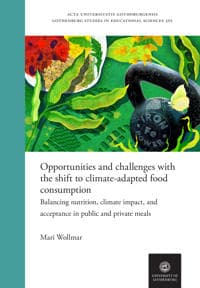
Opportunities and challenges with the shift to climate-adapted food consumption: Balancing nutrition, climate impact, and acceptance in public and ...
342 kr
342 kr
Tidligere laveste pris:
343 kr
Denne artikkelen vil bli
utgitt 29. april 2025
Få artikkelen når den slippes, eller kort tid etter
Sikker betaling
14 dagers åpent kjøp
Selges og leveres av
Adlibris
Produktbeskrivelse
This thesis explores the transition toward climate-adapted food consumption, combining insights from both public and private domains. Through four studies, the thesis investigates the balance between reducing carbon footprint (CO2e) and ensuring nutritional adequacy, revealing overlooked tensions in our shift toward sustainable diets. Rather than presenting findings by individual studies, this thesis organizes results around three interrelated themes that emerged across all four papers. The first theme examines school meals as potential climate champions, revealing both opportunities and challenges in public meal settings. The second theme explores how gender shapes nutritional needs and dietary behaviors in climate-adapted food practices. The third theme investigates the relationship between physical activity levels and CO2e, identifying pathways to unite active lifestyles with sustainability. In school meal menus across Sweden, climate adaptation is taking center stage. Yet beneath these well-intentioned changes lies an unexpected nutritional dilemma. The analysis of municipal school meal programs revealed a troubling relationship, as CO2e emissions decreased, iron bioavailability declined as well. This finding raises important questions about the nutritional adequacy of climate adapted menus, especially for adolescent girls. The paradox became particularly evident in soy-based meals. These meals contained the highest total iron, simultaneously they had the lowest amount of absorbable iron, with minimal bioavailability. None of the analyzed menus provided enough absorbable iron for female pupils with higher needs, highlighting how climate-adapted meal planning may inadvertently create nutritional blind spots. To address this challenge, hybrid recipe formulations that bridged the divide between climate goals and nutritional needs was developed. By combining plant ingredients with modest amount of meat together with vitamin C rich foods, these recipes achieved significant CO2e reductions while maintaining adequate absorbable iron levels. Consumer evaluations revealed that these hybrid approaches maintained high acceptance levels, suggesting that balancing nutrition, taste, and sustainability is entirely possible. Throughout this thesis, gender emerged as a powerful lens for understanding sustainable food transitions. A consistent pattern appeared: women demonstrated stronger climate consciousness in their food consumption but faced greater nutritional vulnerabilities when adopting low-carbon diets. Female participants consistently consumed less energy than recommended, creating a nutritional deficit that impacts micronutrient intake. This was especially pronounced among physically active women, who averaged well below their estimated requirements. This is concerning given their elevated nutritional needs. When examining iron specifically, women’s intake fell below recommendations regardless of dietary preference, with vegetarian and flexitarian diets presenting additional challenges. Gender dynamics significantly shape sustainable food practices beyond just nutritional aspects. The thesis corroborate that women typically lead household shifts toward climate-friendly diets while experiencing more complicated relationships with food choices compared to men. Paradoxically, despite consuming fewer resources and making more climate conscious selections, women experience a greater risk of nutritional deficiencies and health impacts when households transition to sustainable diets. The investigation of recreational athletes and young adults uncovered a clear relationship of dietary CO2e emissions to activity level, with CrossFit athletes exhibiting the highest CO2e emissions, followed by other highly-active individuals and moderately-active participants. The primary driver was not simply higher energy requirements but specifically how these needs were met, predominantly through animal-based protein sources. Yet high CO2e emissions was not inevitable. Several participants achieved notably lower CO2e while maintaining high performance levels through strategic incorporation of plant-based protein sources. These examples challenge the assumption that athletic performance necessarily demands a high environmental cost, suggesting that the barrier lies not in physiological requirements but in cultural norms and established beliefs about nutrition within sports communities. The findings question the assumption that low-carbon diets automatically promote health for all populations. The research shows that sustainable food systems require tailored approaches that consider gender-specific nutritional needs, diverse activity levels, and cultural contexts. The successful hybrid recipes and examples of low-CO2e athletic diets demonstrate that balancing environmental and nutritional goals is achievable with thoughtful planning. The path toward truly sustainable food systems must integrate bioavailability metrics into environmental assessments and address the social practices that shape our food choices. Only then can we create equitable transitions that protect both planetary boundaries and human wellbeing—especially for those leading the way in climate-conscious eating.
Artikkel nr.
ab8bf73b-eb34-543f-b15a-2dec6b5bb7b2
Opportunities and challenges with the shift to climate-adapted food consumption: Balancing nutrition, climate impact, and acceptance in public and ...
342 kr
342 kr
Tidligere laveste pris:
343 kr
Denne artikkelen vil bli
utgitt 29. april 2025
Få artikkelen når den slippes, eller kort tid etter
Sikker betaling
14 dagers åpent kjøp
Selges og leveres av
Adlibris
Lignende toppselgere

4-Pak - Tesla Senterkopper - Bil Svart/silver
129 kr
4,5
mandag, 5 mai

Anti-snork Bånd / Magnetiske Plaster - Stopper snorking
149 kr
mandag, 19 mai

Øreputer for Bose QuietComfort - QC35/QC25/QC15/AE2 Hodetelefoner Svart
99 kr
4,5
mandag, 5 mai

Luftrenseenhet - Renser / Saniterer luften - 20,000 mg/h
599 kr
4,3
mandag, 5 mai

Universallader for Garmin klokker Svart
89 kr
4,2
fredag, 2 mai

4-Pak - Volkswagen VW Senterkopper - Bil 65 mm
129 kr
4,1
mandag, 5 mai

RCA til HDMI Converter 1080p - Adapter
139 kr
4,5
mandag, 5 mai

Hundetrimmer / Potetrimmer - Trimmer for Poter
199 kr
4,3
mandag, 5 mai

Vileda
Rengøringsklud, Vileda PVAmicro, 38x35cm, blå
299 kr
onsdag, 30 april

-2 %
Trådløs CarPlay-adapter 2025
449 kr
Tidligere laveste pris:
459 kr
3,8
mandag, 5 mai
Anbefalinger til dig

INF Filter for MSPA oppblåsbare bassenger FD2089 4-pakning
299 kr
4,8
onsdag, 30 april

INF Hjulmutterhette med fjerningsverktøy, 20-pak 21 mm
95 kr
4,6
fredag, 2 mai

Plenlufter - Piggsko for å lufte plenen
269 kr
4,0
mandag, 5 mai

INF Etterfilter til Dyson V11 / V15 akselstøvsuger 3-pakning
229 kr
3,9
onsdag, 30 april

SERO Apple Macbook magsafe 2 lader, 45 W - for Macbook Air
399 kr
3,7
tirsdag, 29 april

-7 %
INF TYPE-C Dual SD/TF-kortleser for rask dataoverføring 0
99 kr
Tidligere laveste pris:
107 kr
3,3
fredag, 2 mai

3-Pak - Fidget Spinners med Sugekopp for Barn
179 kr
4,4
mandag, 5 mai

Sony
Sony | Playstation® 5 Slim (Digital-versjon) - Spillekonsoll - 1TB SSD NVme - Wi-Fi/LAN - Hvid
5 852 kr
4,6
mandag, 28 april

Sero
SERO Apple Macbook magsafe 2 lader, 60W - for Macbook Pro 13" m. Retina skjerm
349 kr
4,2
tirsdag, 29 april

Limited edition3 for 649 kr
SIGNS STEELBOOK
379 kr
5,0
fredag, 2 mai